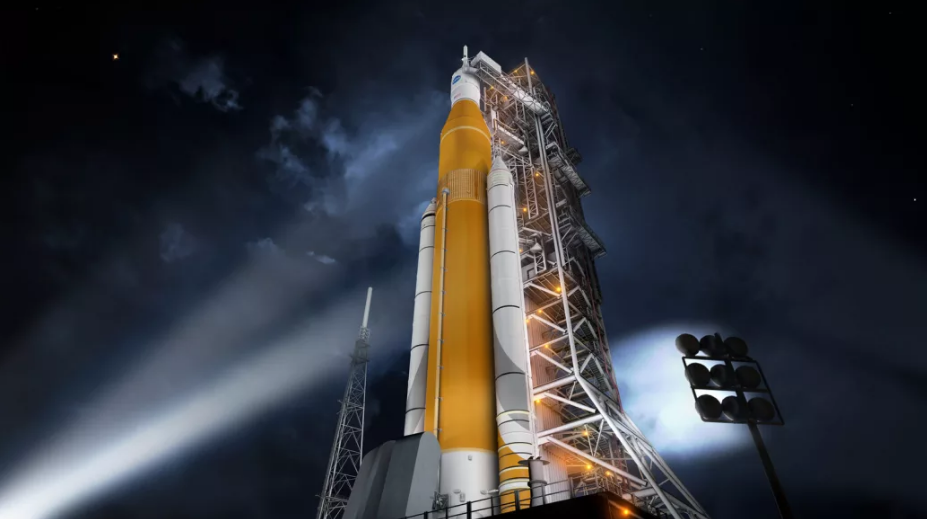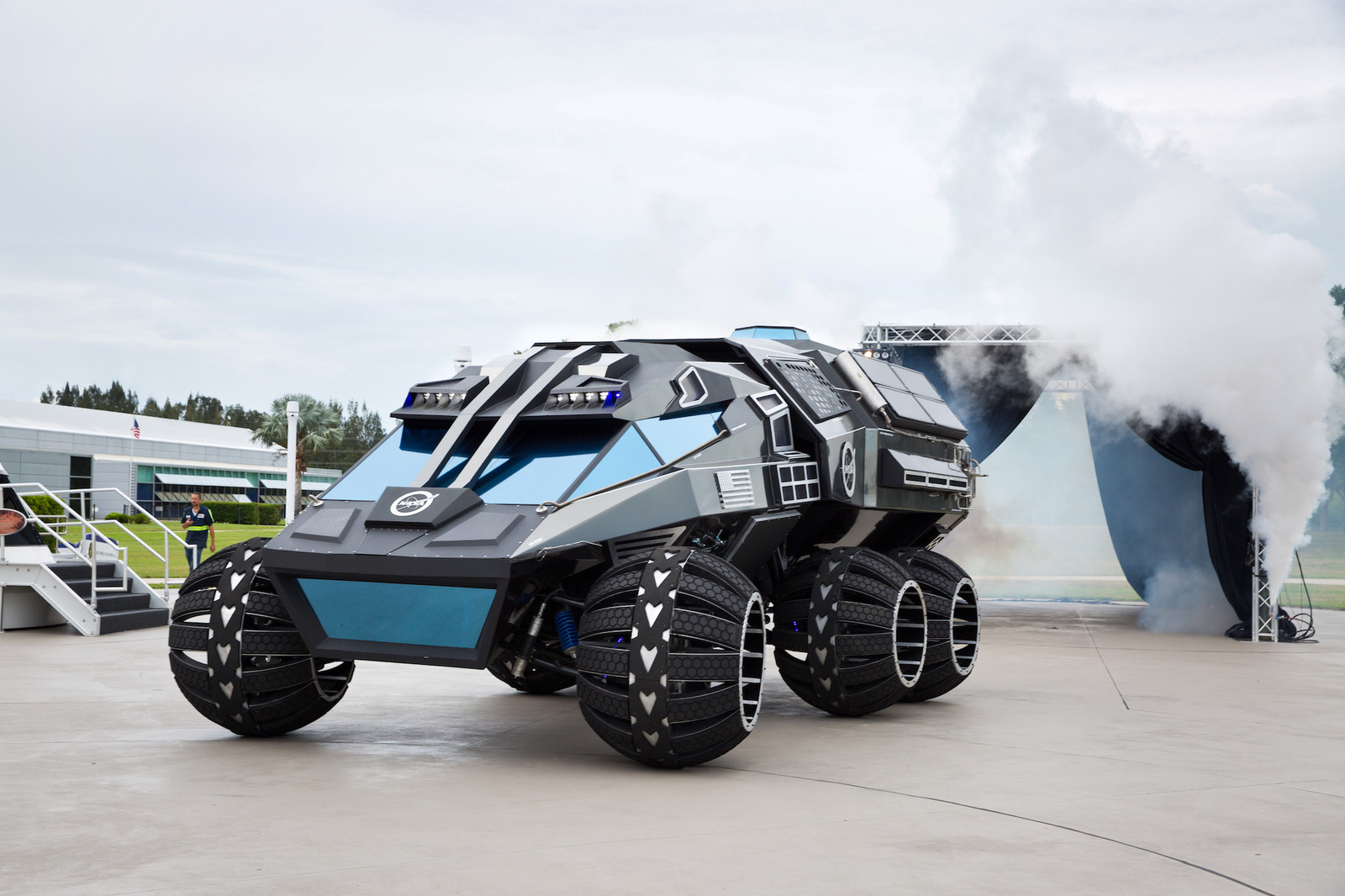
The best looking Mars rover on Earth went on display at the Smithsonian’s National Air and Space Museum last week. The “concept vehicle” appears expensive, sturdy, daring, cutting-edge — basically everything that today’s NASA is not.
“It’s a weird mixture of the Curiosity rover, the Batmobile, and an acid trip,” NASA’s Dave Lavery, program executive for solar system exploration at the space agency, told BuzzFeed News at the museum.
This 5,500-pound aluminum electric truck is nearly 24 feet long and 14 feet tall, and can detach its back half, a mock geology lab. Unlike NASA’s beloved Curiosity and Opportunity rovers, this one has not gone to Mars, and never will. It was built, at the undisclosed expense of the Kennedy Space Center Visitor Complex, to be showcased in parades and exhibits all over the country this summer, wowing the kids.
“If we get a single scientist out of this effort, it will have been worth it,” Therrin Protze, chief operating officer of the visitor center, told BuzzFeed News. “You are basically looking at a concept vehicle that is intended to be inspiring to future generations.”
The reality of the Mars program is nothing like the museum dream car.
The reality of the Mars program is nothing like the museum dream car. NASA, which celebrated its 59th birthday on Saturday, has only a tentative strategy to get to Mars (or anywhere else), and nowhere near enough money to do it. A Congressional hearing last week asked why the Mars 2020 rover will cost $2.1 billion, plus another $300 million to run for a Martian year. That’s $900 million more than the original $1.5 billion estimate for its cost, and NASA only gave 70% odds it would meet that budget number.
The reality of the Mars program is the Mars 2020 Rover behind schedule and at risk of blowing its 26-day launch window, according to the Government Accountability Office, while the space agency is trying to figure out how to pay for it at the same time as a big-ticket mission to Europa and a successor rover designed to collect rock samples from Mars.
The reality of the Mars program is a Congressman, at a public hearing, asking NASA scientists about ancient aliens.
“Was it possible there was a civilization on Mars?” asked Rep. Dana Rohrabacher of California.
“There’s no evidence that I’m aware of,” replied Mars Rover 2020 project scientist Kenneth Farley of the California Institute of Technology, heroically suppressing any hint of a smile.
That moment when you're not sure if the ancient Martian civilization question is a joke or if your agency's funding… https://t.co/zHsqD2fqum
The reality of the Mars program is not having enough money even to keep the current rovers’ data coming back to Earth, as noted by two space policy experts in a new Planetary Society review. The money for a new communications satellite would have to be put into NASA’s budget for next year, a vote that needs to come before October, so that it could happen in the same launch window as the Mars 2020 Rover. And there is no sign of it so far.
“It seems clear from this analysis that NASA is barely keeping the Mars Exploration Program on life support,” the review concludes.
Things aren’t looking too great for NASA’s plan to send people around Mars in the 2030s, either. The Deep Space Gateway plan would put an astronaut habitat in orbit around the moon to serve as a way station to Mars.
NASA’s jumbo Space Launch System (SLS) rocket would have to launch four modules by 2026 to build this habitat. But NASA revealed at the end of April that the SLS’s first launch would slip another year, again, to 2019, which will have cascading effects on all future launches. The original $500 million cost per launch of the rocket has ballooned to $1.5 billion. And to top it off, a NASA official acknowledged two weeks ago, as Ars Technica reported, that the space agency doesn’t have the budget to build something that will land people on Mars, or carry them back off its surface.

This financial shortfall was something a blue ribbon panel report warned would happen in 2009. House and Senate committees have approved spending bills for NASA that include slight increases in its budget, but nowhere near the steady $3 billion a year bumps to the space agency’s budget that the 2009 report described as the only way to get to Mars.
For all the yuks about Rohrabacher's ancient Martians question (the Congressman is a bit of a character), he also noted at the hearing that NASA still hasn’t figured out how to bring back rock samples from Mars, never mind sending a crewed rover like the one at the museum to the planet.
“Certainly if we aren’t comfortable with the idea that we can bring back rocks, we should be focusing on getting that done before we talk about bringing people back,” Rohrabacher said.
Even SpaceX chief, Elon Musk, the most ardent a billionaire fan of off-world colonies there is, has changed his tune somewhat, calling last week for building a moonbase first ahead of sending people to Mars, calling it a “continuance of the dream” of the Apollo astronaut landings.
And yet, the public relations campaign continues as ever. Last month President Trump revived the National Space Council, a panel meant to coordinate U.S. scientific, military, and commercial space plans, handing the job to Vice President Mike Pence (it was last headed by Vice President Dan Quayle during the first Bush Administration).
“Our journey into space will not only make us stronger and more prosperous, but will unite us behind grand ambitions and bring us all closer together,” Trump said at the restart ceremony. “Wouldn’t that be nice? Can you believe that space is going to do that?”
Trump then weirded out Apollo astronaut Buzz Aldrin by replying to an “infinity and beyond” joke with: “This is infinity here. It could be infinity. We don’t really don’t know. But it could be. It has to be something — but it could be infinity, right?”
Buzz Aldrin does not appear to be impressed by Trump's remarks about space.
Mars Day at the museum where the rover prototype was displayed fell on July 21, one day after the anniversary of the first moon landings 48 years ago. For now, we are much closer to those astronauts on the moon almost a half-century ago than ever seeing people driving on Mars. To infinity and beyond might be how long it takes to change that. ●


